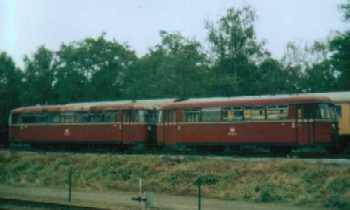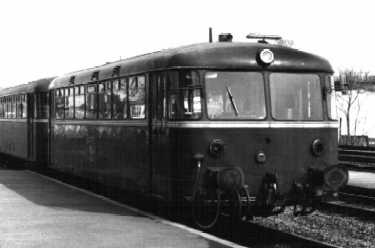| The Bundesbahn's railcars "Schienenbusse" |
![]()
s.jpg) (Photo) Schweineschnaeuzchen |
| The 'Schienenbusse' (something like railbus) became common in the fifties, although there had been some similar vehicles in former times. For example the Royal Saxonian Railways used some at the beginning of the century and the former Reichsbahn and private railway companies tested several models for it is well-known that operating branch lines is relatively expensive. So there was need of railcars which weren't too expensive neither in purchase nor in service. The certainly best known was the so-called "Schweineschnaeuzchen" (pig's mouth) or "Ameisenbaer" (ant eater). Nevertheless none of these railcars could substitute the enormous amount of steam locos which were still in use. |
| After WW II the situation became worse. The number of private owned cars dramatically increased and the just founded Bundesbahn again had to look for ways of economically efficient ways of operating branch lines. So in 1949 the company "Waggonfabrik Uerdingen" in Krefeld was entrusted with the development of a new railbus. In 1950 the Bundesbahn got 11 prototypes, VT 95.901 - VT 95.911 with 110 h.p. diesel engines by Buessing in underfloor arrangement. They were shorter than the later models, the distance of their axles was 4,500 mm. It was obvious that the number of seats (VT 95.901 - VT 95.910: 41; VT 95.911: 43) was too low and in 1951 a longer railcar VT 95.9112 was built. As the distance of axles was longer (6,000 mm) than allowed in the "Eisenbahn-Bau- und Betriebsordnung" (EBO) a special approval was necessary. All the prototypes were withdrawn in the sixties. |
| The first full-scale class, including 496 vehicles was introduced in
1952. They all got a single engine with (later) 150 h.p. Their weight was
only 15.2 to and the maximum speed 90 km/h. These dark red railcars helped
to delay or even avoid the closure of many rural branch lines, called "Retter
der Nebenbahnen" (Saviour of branch lines). The single-engine VT 95s
have all been withdrawn from service. From 1953 three prototypes of more powerful railcars with two 150 h.p. engines each was delivered followed by a series of 329 vehicles (VT 98.9501 - VT 98.9829) from 1955 - 1962. Both VT 95 and VT 98 got driving (only VT 98) and non-driving trailers to make up longer trains. Different from class VT 95 and class VT 98 got the usual coupling and buffers (VT 95 had couplings of the type 'Scharfenberg' and VERY simple buffers). So they were also able to carry some usual passenger or freight coaches. During the following decades these railcars could be seen everywhere on the Bundesbahn's lines, as trains on branch lines but even as passenger trains and semi-fast trains on main lines. Nowadays there are only few VT 98 in service, around Tuebingen. Even a small class of VT 97 (VT 97.901 - VT 97.908) with rack and pinion drive were built from 1961 for the line from Honau to Lichtenstein in Wurttemberg. |
| In 1968 the railcars were renumbered: |
| VT 95 --> 795 (railcar, one engine) VB 142--> 995 (non-driving trailer) VT 98 --> 798 (railcar, two engines) VB 98 --> 998.0 - 3 (non-driving trailer) VS 98 --> 998.6 - 9 (driving trailer) VT 97 --> 797 (railcar) VB 97 --> 997.001 (non-driving trailer, only one vehicle) VS 97 --> 997.6 (driving trailer). |
 (Phoyo) Class 795 |
 (Photo) Class 798 |
![]()
| Pictures of Schienenbusse |
![]()
| Back |